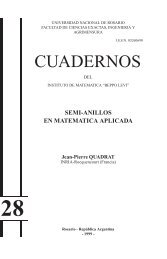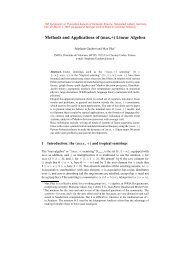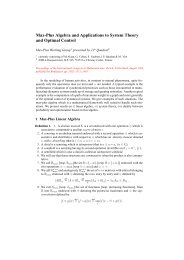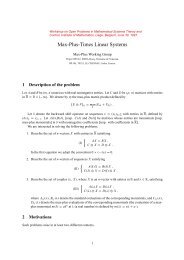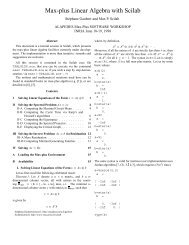View - Jean-Pierre QUADRAT - Free
View - Jean-Pierre QUADRAT - Free
View - Jean-Pierre QUADRAT - Free
You also want an ePaper? Increase the reach of your titles
YUMPU automatically turns print PDFs into web optimized ePapers that Google loves.
not allowed not allowed input controlled by output(a) (b) (c)Figure 3: About event graphsWe are interested in timed event graphs. Without loss of generality, we mayconsider that transitions are immediate and that holding times (represented bybars in time units) apply only to places. As a matter of fact, if a transition hassome duration, we may split it into two distinct transitions, the beginning andthe end, separated by a place bearing the corresponding time (see Figure 3-(c)).Moreover, if it is meant that a new activation of the transition cannot occurbefore the end of the previous activation, it suffices to put a feedback arc witha place marked with one token. Moreover, this place can incorporate a holdingtime equal to some “reset time” if necessary.The holding time at a place means that tokens must stay at least that timein the place before being available for downstream transition firing. This poses aproblem concerning tokens of the initial marking: are they immediately availableat the beginning of the game, or after which time will they be available 9 ? For thetime being we assume the following canonical initial informations 10 : tokens ofthe initial marking are available immediately. More general initial informationswill be discussed later on. We assume that transitions are fired immediatelywhen they can be fired (otherwise, the behaviour would not be deterministic).Events of interest in a timed event graph are the transitions firings and thearrivals and departures of tokens at and from places. Events of a given type(firing of transition x, arrival at place y|x, etc ...) are numbered sequentiallyas they occur. To completely describe the behaviour of a timed event graphalong time, it suffices to record the sequences of dates for all events of all types.9 In this latter case, the time after which they are available should be less than or equal to theholding time of the place.10 We say “initial informations” rather than “initial conditions” for reasons that will be moreapparent later on.26



